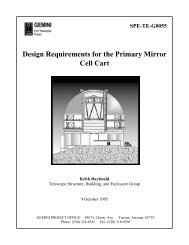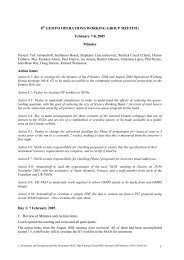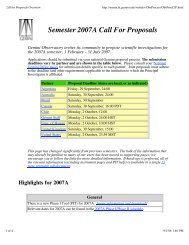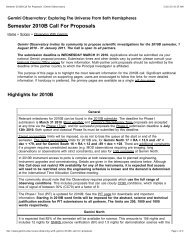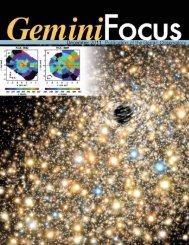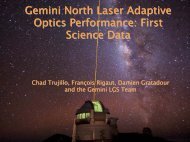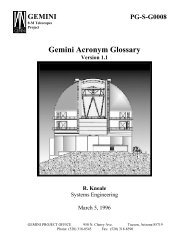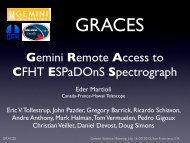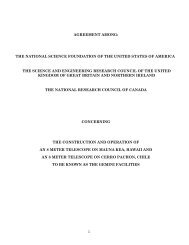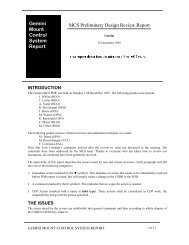Seismic Design - Gemini Observatory
Seismic Design - Gemini Observatory
Seismic Design - Gemini Observatory
You also want an ePaper? Increase the reach of your titles
YUMPU automatically turns print PDFs into web optimized ePapers that Google loves.
<strong>Seismic</strong> <strong>Design</strong><br />
A Structural Engineering Perspective<br />
Mike Sheehan<br />
March 23, 2007<br />
MKO Earthquake Workshop
Overview<br />
• <strong>Seismic</strong> Environment Defined<br />
• <strong>Gemini</strong> Telescope <strong>Seismic</strong> <strong>Design</strong> Process<br />
• <strong>Gemini</strong> Safety Restraint Features<br />
March 23, 2007<br />
MKO Earthquake Workshop
<strong>Seismic</strong> Environment<br />
• <strong>Seismic</strong> <strong>Design</strong> Requirements<br />
– Uniform Building Code<br />
• Plus Hawaii State provisions<br />
– International Building Code<br />
– Other local codes<br />
• UBC and IBC <strong>Design</strong> Choices<br />
– Static Lateral Force Procedure<br />
– Dynamic Analysis<br />
Requirements change over time to reflect new knowledge of the<br />
seismic environments<br />
–Hawaii change from Zone 3 to Zone 4 in the late 90’s<br />
–<strong>Seismic</strong> retrofit should therefore be a big consideration for all<br />
Observatories<br />
March 23, 2007<br />
MKO Earthquake Workshop
<strong>Seismic</strong> Environment<br />
• Static Lateral Force Procedure<br />
– Peak base shear force is calculated by manipulation of loads of<br />
information including:<br />
• Soil profile type<br />
• <strong>Seismic</strong> source classification<br />
• Structural configuration<br />
• Proximity to the source<br />
• Ground response coefficients<br />
• Response spectra<br />
• Redundant load path considerations<br />
• <strong>Seismic</strong> zone factor<br />
• <strong>Seismic</strong> dead load<br />
• Fundamental period of vibration of the structure<br />
March 23, 2007<br />
MKO Earthquake Workshop
<strong>Seismic</strong> Environment<br />
• Static Lateral Force Procedure<br />
– The distribution of the base shear force throughout the structure is based<br />
upon mass and distance from the soil<br />
F 4<br />
NOT VERY GOOD FOR<br />
F<br />
LARGE 3<br />
TELESCOPE DESIGN<br />
F 2<br />
F 1<br />
h<br />
V<br />
March 23, 2007<br />
MKO Earthquake Workshop
Dynamic Analysis<br />
• Dynamic Analysis<br />
– Based upon “Appropriate Ground Motion Representation”<br />
– Performed using “Accepted Principles of Dynamics”<br />
• Ground Motion Definition<br />
– Based upon a seismic event that has a 10% probability of being exceeded<br />
in 50 years<br />
– Characterized by:<br />
• Response spectrum<br />
– Normalized spectrum defined in the codes<br />
– Site-Specific response spectrum<br />
• Representative ground motion time histories<br />
• Analysis<br />
– Three dimensional model required<br />
– Enough modes to describe total structural response<br />
March 23, 2007<br />
MKO Earthquake Workshop
Site-Specific <strong>Seismic</strong><br />
At a specific site –<br />
Hazard Analysis<br />
• The Site-Specific SHA answers the questions<br />
– What is the probability that certain ground motion criteria will occur<br />
within a given period of time?<br />
– What is the likelihood that certain seismic events will occur that will have<br />
an impact on the design of structures at a particular site.<br />
Then - with some set criteria –<br />
The SHA defines the design seismic environment in such terms that a<br />
proper structural analysis and design can proceed.<br />
March 23, 2007<br />
MKO Earthquake Workshop
History<br />
Site-Specific <strong>Seismic</strong><br />
Hazard Analysis<br />
Destructive Earthquakes in Hawaii Since 1868<br />
Date Location Magnitude<br />
28 Mar 1868 Southern Hawaii 7.0<br />
02 Apr 1868 Southern Hawaii 7.9<br />
05 Oct 1929 Hualalai 6.5<br />
21 Aug 1951 Kona 6.9<br />
26 Apr 1973 North of Hilo 6.2<br />
29 Nov 1975 Kalapana 7.2<br />
16 Nov 1983 Ka’oiki 6.7<br />
25 Jun 1989 Kalapana 6.2<br />
15 Oct 2006 Kiholo Bay 6.7<br />
March 23, 2007<br />
MKO Earthquake Workshop
Site-Specific <strong>Seismic</strong><br />
Hazard Analysis<br />
Project the Ground Motion from the Source to the Site<br />
Use of Ground Motion Attenuation Equations<br />
•Source to Site distance<br />
•Source depth<br />
•Geology and Site soil conditions<br />
•Other factors<br />
March 23, 2007<br />
MKO Earthquake Workshop
• Establish your own <strong>Design</strong> Criteria<br />
Site-Specific <strong>Seismic</strong><br />
Hazard Analysis<br />
– Codes requires that you design for the “Survival Event”<br />
• This is defined as an event that has a 10% probability of being exceeded in 50<br />
years.<br />
• In this case, structural elements are required to stay intact.<br />
• Some limited failures are expected.<br />
– At <strong>Gemini</strong>, we have looked at an “Operational Event” as well.<br />
• This was chosen to be an event that produced seismic loads at a level of 80%<br />
of the Survival Event.<br />
• In this environment, the general requirement is that the telescope recover to<br />
full operational capacity within a given (short) period of time.<br />
March 23, 2007<br />
MKO Earthquake Workshop
<strong>Design</strong> levels for Peak Ground Acceleration<br />
Site-Specific <strong>Seismic</strong><br />
Hazard Analysis<br />
Survival Event<br />
10% Probability<br />
of exceeding in 50 years<br />
Average Return Period = 500 years<br />
PGA = 0.40 g<br />
Operational Event<br />
22% Probability<br />
of exceeding in 50 years<br />
Average Return Period = 200 years<br />
PGA = 0.32 g<br />
March 23, 2007<br />
MKO Earthquake Workshop
Site-Specific <strong>Seismic</strong><br />
Hazard Analysis<br />
Horizontal Ground Motion Response Spectrum<br />
Operational Event<br />
March 23, 2007<br />
MKO Earthquake Workshop
Site-Specific <strong>Seismic</strong><br />
Hazard Analysis<br />
Horizontal Ground Motion Response Spectrum<br />
Survival Event<br />
March 23, 2007<br />
MKO Earthquake Workshop
Site-Specific <strong>Seismic</strong><br />
Hazard Analysis<br />
Vertical Ground Motion Response Spectrum<br />
Vertical Ground Motion Response Spectrum<br />
1<br />
Acceleration (g)<br />
0.1<br />
200 yr Event<br />
500 yr Event<br />
•Note that Codes typically scale the vertical<br />
response spectrum at 2/3 the horizontal<br />
spectrum. Here at 10 hz, the vertical and<br />
horizontal spectral values are equal.<br />
0.01<br />
0.01 0.1 1 10<br />
Period (sec)<br />
March 23, 2007<br />
MKO Earthquake Workshop
Site-Specific <strong>Seismic</strong><br />
Hazard Analysis<br />
• Generation of Site-Specific ground motion acceleration time<br />
history records<br />
– Use recorded ground motion records from sensors located near the site.<br />
– Calculate the response spectra based upon the measured data.<br />
– Modify the data as necessary so that the response spectra calculated from<br />
the recorded data matches that calculated for the site in the SHA<br />
March 23, 2007<br />
MKO Earthquake Workshop
Ground Motion Time Histories<br />
Site-Specific <strong>Seismic</strong><br />
Hazard Analysis<br />
Modified Mauna Loa Weather <strong>Observatory</strong> Accelerogram from 11/16/83 Earthquake<br />
D&M Data Set COMP2A<br />
0.4<br />
0.3<br />
300 o Component Acceleration (G)<br />
0.2<br />
0.1<br />
0<br />
-0.1<br />
-0.2<br />
-0.3<br />
-0.4<br />
0 5 10 15 20 25 30 35 40 45<br />
Time (sec)<br />
March 23, 2007<br />
MKO Earthquake Workshop
Comparison of October 15 th Event to <strong>Design</strong><br />
4.00E-01<br />
MK Ground Motion<br />
15 Oct 06 Earthquake<br />
3.00E-01<br />
H Comp 1<br />
Vert Comp<br />
H Comp 2<br />
<strong>Design</strong><br />
2.00E-01<br />
Acceleration (cm/sec^2)<br />
1.00E-01<br />
0.00E+00<br />
-1.00E-01<br />
-2.00E-01<br />
-3.00E-01<br />
-4.00E-01<br />
0.000 5.000 10.000 15.000 20.000 25.000 30.000 35.000 40.000 45.000<br />
Time (sec)<br />
March 23, 2007<br />
MKO Earthquake Workshop
Analysis<br />
Finite Element Model<br />
Modes sufficient to<br />
characterize the<br />
dynamic response<br />
through ~25 hz<br />
Mass and Interface<br />
Stiffness for fragile<br />
Subsystems<br />
Azimuth and Elevation<br />
Interface Stiffness<br />
Modal damping<br />
estimates are important<br />
Pier Mass<br />
Soil Stiffness<br />
March 23, 2007<br />
MKO Earthquake Workshop
Analysis<br />
Response Spectrum Analysis<br />
For each mode or interest –<br />
determine the acceleration response<br />
from the response spectrum design<br />
curve<br />
The response is shown for 5% damping.<br />
In most cases, telescope modal damping<br />
values are far less. Therefore, scale the<br />
acceleration response (up) for the<br />
appropriate level of modal damping.<br />
Combine the peak modal responses in<br />
a rational way (RSS)<br />
March 23, 2007<br />
MKO Earthquake Workshop
0.4<br />
0.3<br />
0.2<br />
0.1<br />
-0.1<br />
-0.2<br />
-0.3<br />
-0.4<br />
0<br />
0 5 1 0 1 5 2 0 2 5 3 0 3 5 4 0 4 5<br />
Analysis<br />
• Transient Analysis<br />
March 23, 2007<br />
MKO Earthquake Workshop
Analysis Results<br />
In General - Response Spectrum and Transient Analysis results<br />
should be similar<br />
• Results of interest<br />
– Global telescope structure response<br />
• High stress areas at risk of permanent deformation<br />
• Uplift<br />
– Telescope Interface Loads<br />
• Bearings, Drives, Brakes, Track & Drive Disk<br />
– Interface Loads to Fragile Subsystems<br />
– Subsystem rigid body (or elastic) response<br />
• Provide seismic design requirements for subsystems<br />
March 23, 2007<br />
MKO Earthquake Workshop
<strong>Seismic</strong> Restraints<br />
• Process<br />
– Identify fragile sub-systems<br />
– Assess Sub-system response in both Survival and Operational <strong>Seismic</strong><br />
Environments<br />
– Address the fragility level of the sub-system to the seismic response<br />
– Define the need for seismic restraints on these subsystems<br />
– <strong>Design</strong> these sub-system restraints<br />
OR<br />
– Calculate the sub-system design environments<br />
– Impose these environments as a part of design specifications<br />
March 23, 2007<br />
MKO Earthquake Workshop
<strong>Seismic</strong> Restraints<br />
M2 Followers<br />
M1 Safety Restraint System<br />
<strong>Seismic</strong> Restraints<br />
on Az and El axes<br />
March 23, 2007<br />
MKO Earthquake Workshop
<strong>Seismic</strong> Restraints<br />
Telescope Overturning Restraints<br />
March 23, 2007<br />
MKO Earthquake Workshop
<strong>Seismic</strong> Restraints<br />
• M1 Restraint System<br />
March 23, 2007<br />
MKO Earthquake Workshop
Conclusion<br />
• Analysis/<strong>Design</strong> Process<br />
– Good for assessment of current design<br />
– <strong>Seismic</strong> retrofit<br />
• Applies to Telescopes in particular, but in general<br />
– Enclosures<br />
– Support Facilities<br />
– Piping systems<br />
– Tanks<br />
– Book cases<br />
Any structure at risk of damage resulting from<br />
being subjected to the effects of a seismic event<br />
March 23, 2007<br />
MKO Earthquake Workshop



